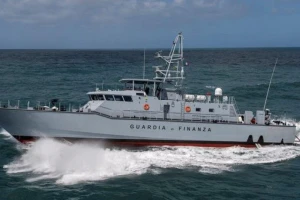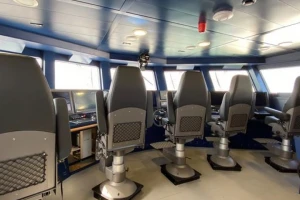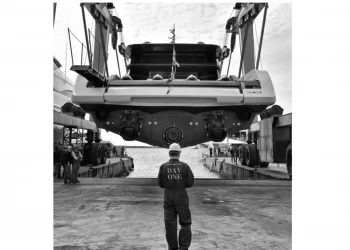
With the Effebi 44M CPV, Studio Arnaboldi revolutionises patrolling at sea
With Effebi 44M CPV, Studio Arnaboldi revolutionises patrolling at sea
We are used to seeing the Arnaboldi studio of the Viareggio engineer Marco Arnaboldi designing 50 metre (and over) superyachts that cruise at 50+ knots, or luxurious limo tenders that combine performance with exclusive construction and furnishing solutions. But when your knowledge of design is almost all-encompassing, from the study of the hulls to construction with advanced composite materials, paired with innovative propulsion solutions such as water jets, no marine area is out of bounds. The demonstration is not a project on paper, but a fast patrol boat that has already been sailing for two years, confirming all the extraordinary performances hypothesized in the design phase: the Effebi 44M CPV, which Studio Arnaboldi designed and helped to build in the Effebi Spa shipyard in Viareggio.
“Effebi 44M is the result of a call for tenders from the Italian Guardia di Finanza [Financial Police], with consultancy from the Italian Navy, asking for a fast patrol vessel that had to meet a series of fairly complex requirements,” says Marco Arnaboldi. “It had to be fast for pursuits in the context of transit, maritime surveillance, development of Maritime Situational Awareness (MSA), fighting illegal immigration and illicit trafficking by sea under national control and included in multinational mechanisms under the control of the Frontex Agency, but it also had to be efficient at low speed for routine patrols, welcoming because it had to accommodate a crew of 23 people for several days and, finally, require as little fuel as possible to ensure long range."
The project developed by Studio Arnaboldi and presented by Effebi Spa therefore envisaged a boat built in advanced composite materials, mainly carbon, which guaranteed up to 40% weight reduction compared to more traditional constructions. The shipyard's expertise and Marco Arnaboldi's consultancy in the processing of carbon composites were an absolute competitive advantage in this aspect. The lightness of the hull translated into less powerful engines being needed to achieve the performance required for the tender, therefore lower consumption and fewer fuel reserves (less than half!) to guarantee the range established by the Guardia di Finanza.
This was the background leading to the Effebi 44M CPV project. Not only was the contract awarded, but the boat has been at sea for two years now, with over 2,000 hours of navigation as part of its activity for Frontex, the European border and coast guard agency tasked with the control and management system of the external borders of the Schengen area and of the European Union. An integral part of the tender was the creation of a first model before starting the production of six other sisterships.
“The construction is based on lightness criteria derived from our experience with high performance yachts, so it was not a problem to achieve the design performance required by the Guardia di Finanza using about half the power that would have been necessary if it had been conceived following traditional methods for designing such vessels,” explains Marco Arnaboldi. “The propulsion package consists of four MTU 16V2000s of 2600 hp each, coupled with as many MJP 650 water jets, which also allows fractional use of the propulsion and therefore doubling the time between maintenance sessions compared to traditional systems; after more than 2,000 hours of navigation, we have not yet had to carry out any maintenance.”
Another fundamental aspect is the deep V hull, expressly designed for coupling with water jet propulsion. When it was tested in the tank of the Krylov State Research Centre in St. Petersburg and in the Vienna Model Basin, it was certified as the most efficient hull that Krylov's technicians had tested until then. Therefore, while guaranteeing excellent seaworthiness in rough sea conditions, it also has low drag which guarantees comfortable navigation at the maximum speed of 47 knots, while the 43 knots required by the tender are achieved using only 90% of the power. But maximum speed is only used for pursuits, while 37 knots are sufficient for fast transfers. While patrolling, 14 knots are enough and only two engines are used.
“In these two years of service for Frontex, the CPV collaborated with the Spanish Guardia Civil, which expressed great appreciation,” remembers Marco Arnaboldi. “The lightness of the construction has made it possible to set up particularly welcoming and comfortable interiors, decidedly superior compared to existing military vessels, for the 23 crew members who have to sail non-stop for an average of 14 days. Some operators have stated that the patrol boat transmits such a feeling of safety, that sometimes there is a risk of exceeding the speed recommended for the sea conditions, but they have never found themselves in extreme situations."
The Effebi 44M CPV is 44 meters long overall, 38.52 m at the waterline, with a 8.60 m maximum beam and a full load displacement of only 202 tons. The fuel tanks can hold up to 35,000 litres of diesel and the water tanks 5,000 litres. Another original feature is the slipway at the stern, which allows for the quick hauling of a 7.50-metre dinghy while sailing. In these two years, Effebi 44M has successfully completed various missions to control clandestine immigration and drug trafficking, contributing to border security and saving human lives.







